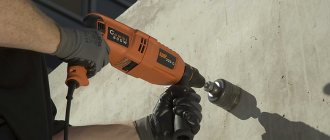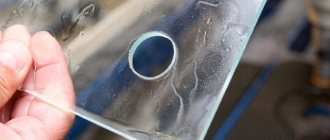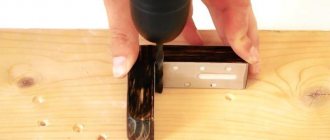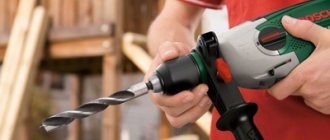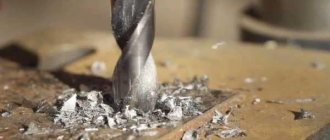In connection with the development of the metallurgical industry, a variety of metals and their alloys appear on the market. Metal can replace steel since it is a material with a high price. When carrying out processing, you need to know how to drill cast iron in industrial production conditions and private workshops.
Drilling cast iron using a machine
Features of cast iron
The main difference between metal is the manufacturing process. Various temperatures are used in production, reaching values of 1200°C. In this case, an alloy of iron and carbon with a high content of the latter is obtained, this phenomenon helps to reduce the strength properties. Iron and carbon particles do not form strong bonds.
During the melting process, carbon atoms are not able to integrate into the crystal lattice. As a result, cast iron parts are not used in units subject to high loads. The metal belongs to ferrous metallurgy and has some characteristics similar to steel alloys.
The advantages include:
- the high strength of some cast iron alloys, in contrast to steel;
- as a result of forced heating, thermal energy is evenly distributed throughout the part, while the temperature decreases over a long period of time;
- does not react with acids and alkalis;
- cast iron parts have a long service life;
The disadvantages include:
- low resistance to corrosion;
- you can drill cast iron only if you have the skills and additional equipment;
- low plasticity properties;
- high fragility of some metal alloys.
Tapping with a tee
Installation of such a device is possible both on a transit riser and in an existing outlet. In this case, the tee will be used as an additional element of the system's indoor wiring. The first option involves cutting out part of the riser and replacing it with the required unit. This operation can be performed using plastic or cast iron fittings. Most often, PVC products are used. This makes the assembly and installation of the tee much easier.
The installed unit is assembled separately in the room. In addition to the tee, experts recommend using a compensator. It will identify any inaccuracies in the marking of the insertion site and will facilitate installation. Before cutting out the required section of 110 mm pipe, it would be useful to secure the transit riser with fastening clamps to fix it immovably. Fasteners are installed below and above the cut part. In this case, you must not forget to make allowances for the installation and movement of the compensator (adapter).
Cut the pipe with a grinder. If it is not possible to make a circular cut, then it is completed using a hacksaw for metal. Experts do not recommend trying to do this with a hammer and chisel, because... The required part of the riser may collapse. The outer walls for planting are cleaned with a metal brush or scraper, and burrs are removed with a file. Before installing the fittings, the seats must be coated with sealant and the installation of the rubber O-rings must be checked.
The compensator is installed first and moves up for ease of installation of the tee. After its installation, the previously installed part is moved and secured in the socket. In order to remove unpleasant odors, the pipe is closed with a plug.
Installing a tee indoors is easier. The main difficulty lies in caulking the old input. For installation, shaped parts made of PVC are used. It is better to use bitumen-based mastics and pastes as a sealant.
How to drill cast iron
For metal processing in a private workshop, electric drills are used with the ability to adjust the speed of the spindle with the tool. The device must have a high power rating in order to drill a large diameter hole in the metal.
In industrial production, special high-power equipment is used, as well as those with program control. At the same time, the system monitors the spindle speed, the temperature of the tool and workpiece, as well as the amount and pressure of the coolant during processing.
For processing cast iron, ordinary metal drills are used. However, one of the conditions for them is a certain sharpening angle of the cutting edge. Before work, select drills of the required design. To perform the processing, devices are used to secure the drill and the workpiece, while avoiding drill misalignment, which increases the accuracy of the hole.
What drills are used
When drilling, the following types of tools are used:
- drill for cast iron with a sharpening angle of no more than 118°;
- a tool with carbide inserts on the cutting edge, most often used to win;
- tool of a certain diameter.
Drill sharpening angle
How to drill cast iron at home and with professional equipment
Industrial development leads to the emergence of new materials with properties in demand for modern products and assemblies.
Despite this fact, cast iron, in all its diversity, remains an iron-carbon alloy, without which it is difficult to imagine any sector of everyday life, communications system or production equipment.
Fittings, shut-off valves, pipes, bathtubs, heating radiators, fastening elements for railway tracks and brake pads for cars, cast parts replacing steel ones. These are the components of a list that can be continued for a long time.
The processing of this material deserves special attention for large enterprises and home craftsmen. One of the main aspects is how to drill a hole in cast iron.
Subtleties of working with cast iron
Following simple rules will allow you to achieve the desired result, leaving the drills, tools, and hands intact:
- Control the load applied to the drill or machine without causing the drill to break. Cast iron products are mainly produced by casting. Shrinkage cavities and voids may appear. If a drill falls into such a void, it breaks in 95% of cases. There is a risk of injury or a broken drill bit in an unfinished hole.
- Do not allow the drill to overheat. Take a break from work. This will prevent the metal from softening and will extend its service life.
- To drill into a cast iron bathtub, use a pre-diamond tile and glass drill bit. This is a simple move to prevent cracking of the enamel.
- If the diameter exceeds 11mm, then the optimal solution would be to use a drill of a smaller diameter, and then the required size.
With the right approach and care, drilling into cast iron is not an impossible task. The information presented in this article gives a complete understanding of how to drill cast iron, all the nuances and subtleties.
How to drill cast iron
Drills with a mechanism for adjusting the speed of the chuck
For drilling at home, simple drills with a mechanism for adjusting the speed of the chuck are used. Such a tool for drilling cast iron must have sufficient power, especially if there is a need to drill a hole of significant diameter.
In industrial conditions, professional drilling equipment equipped with automatic control systems is used.
Electronics allows you to control not only the rotation speed and feed rate of the cutting tool, but also the heating temperature of the drill and the volume of coolant supply.
It is depending on the temperature conditions that the drilling parameters are adjusted.
Drilling at home will be carried out using a special device for cutting cast iron, which allows you to fix the drill motionless. This ensures the durability of the drill used, which usually breaks precisely due to tool distortions during the drilling process.
Drill selection
Drills for metal work
- Ordinary metal drills can cope with this task. Only such consumables must be sharpened properly. It has been proven in practice that sharpening at an angle of 116 to 118 degrees is considered the most effective.
- Drills with carbide inserts are also used (most often they will win). It is best to use special pobedit drills for metal; they have a slightly different design. But specialists can cope quite well with conventional drills of this type for concrete and brick, only they are pre-sharpened on a diamond wheel.
↑
Subtleties of drilling cast iron
To successfully drill a cast iron pipe, you need to learn two basic subtleties:
- It is necessary to control the load applied to the tool, but do not lean on the drill. The fact is that solid cast iron may contain voids, this especially often happens when casting technology is not followed. It is at the moment of transition from metal to such a sink that most drills break; among other things, at this moment there is a real threat of injury.
- Do not allow the drill to overheat and blacken; to do this, you must take breaks from work or use coolant (ordinary water at home).
Drilling is used to insert into cast iron pipes; large diameter holes must be made in two steps. First of all, a hole is drilled with a drill of minimum diameter, after which you can begin to use the appropriate cutting tool.
The technology of drilling cast iron itself is quite simple; the main thing is to be careful and perform the work with extreme care and accuracy.
And you should not try to drill pipes made of high-strength cast iron yourself; a positive result is unlikely to be obtained, and the number of broken drills will be significant.
Methods for drilling cast iron pipes
When installing sewerage or water supply systems, cast iron pipes are used. To create connections for transitions and inserts, you need to make holes. Processing is carried out in the following ways:
- industrial equipment;
- electric drills;
- using hand-operated devices.
How to drill a cast iron pipe
The processing speed can be affected by the technical characteristics of the metal. Some types of alloy can be drilled at high speeds and do not require the use of lubricants or coolants.
Different workpieces are subjected to different processing methods. For materials with high strength, metal drills with a sharpening angle of the cutting surface of 116° are used. If the master does not have a tool of the required diameter, you can use a set of different sizes. The work begins with a small drill, then the diameter of the tool is increased, thus achieving the desired result.
During processing, the drill heats up; to prevent tool defects, it is necessary to use water to reduce the temperature. The number of revolutions is gradually increased; it is forbidden to apply increased force to the device.
In a private workshop, drills with overlays made of pobedite are used. In this case, it is recommended to maintain a vertical position and low spindle speeds. During processing, the temperature of the workpiece and drill is monitored. Changes in color of the material as a result of sudden temperature changes are not allowed.
For industrial processing, machines with high rated power and high rotation speeds are used. During the drilling process, lubricating and cooling fluids are supplied to the workpiece and tool. At the same time, the normal temperature of the processing zone is maintained.
Faucet materials
- Traditionally, the main materials for the manufacture of faucets remain chrome and brass. The base of the device is made from brass, which is then chrome or nickel plated. Products with chrome coating are more hygienic, because chromium has a negative effect on microorganisms;
- In the modern production of plumbing components, plastic has taken a strong position. The market is flooded with cheap Chinese materials. In this case, cheap does not mean good. Those who install a Jacuzzi bathtub will not allow a plastic faucet to be installed on it. The design of the mixer with a plastic casing, handle or watering can is allowed;
- In pursuit of comfort, exclusivity and luxury, faucets are made from pure chrome, marble, granite, and custom-made trimmed with precious metals and stones.
At what height should I install the washbasin in the bathroom?
Preparatory stage and necessary tools
Immediately before starting work, it is necessary to prepare the surface of the workpiece on which the hole will be made. In this case, burrs are removed from the part; in this case, sandpaper is used, as well as oily and greasy stains. As a result, the master will achieve normal heat removal from the drilling site.
With a sharp cooling of heated areas, the metal bleaches; this phenomenon occurs as a result of the structural structure of the material. The bleached area is characterized by low strength as well as brittleness. Mechanical loads can lead to defects in the metal workpiece.
Large industrial enterprises use emulsions to cool workpieces and tools. They contain sulfonated and chlorinated oils; in some cases, a kerosene solution is used. Thanks to this liquid, it is possible to avoid changes in the structure of the metal. For machine tools, one of the conditions is a smooth change in the spindle speed, as well as a smooth lowering of the drill into the workpiece.
In a private workshop, electric drills with the ability to adjust rotation are used. Drive motors must be selected with high power, and the master will receive holes of large diameters. To prevent drill breakage, as well as maintain processing accuracy, a mechanism for securing the workpiece and the machine is used.
Drilling tool
Decorative pond
Do-it-yourself washbasin for your dacha: from bottles and canisters, “moidodyr” and portable
It's very easy to create a decorative pond from an old bathtub.
- We determine the place where the future decorative pond will be located. It can be organically integrated into landscape design. According to the teachings of Feng Shui, this can be the eastern or southern part of the summer cottage;
- We dig a deep pit slightly larger than the bathtub. Remove the top layer of soil around;
- We place the bathtub inside the pit, level it, fill the gaps with sand;
- We close the drain and side holes of the container so that water does not spill out;
- We cover the inner walls with tile adhesive. This will give the surface the color and structure of the bottom of a real pond. Leave to dry for a day;
- We cover the edges of the bathtub with a metal mesh, fill it with cement, and lay crushed stone or small stones on top;
- Pour a layer of dry clay onto the bottom, make a thick solution, coat the walls and leave until completely dry;
- We decorate the pond with aquatic plants and stones.
Carrying out work
When performing drilling processing, the following recommendations must be observed:
- Constant control over the force on the tool. As the load increases, defects in the form of cracks and cavities may appear on the metal. If the drill breaks, the technician may be injured.
- Overheating is not allowed during processing. Increasing the temperature of the workpiece will change the structure of the metal, causing it to become brittle.
- Before drilling, the surface of the part is prepared and the drilling site is cored.
- If the hole diameter exceeds 10 mm, then a tool kit must be used. They start with a small diameter and gradually achieve the desired one.
As a result of following the technology of machining cast iron parts, a master can achieve high precision holes.
Mortise using an overlay
This operation is performed without removing a segment of the riser. To do this, it is necessary to accurately determine the insertion point, drill or
cut a hole and install an adapter with a branch of the required size. Installation of the lining can be carried out on pipes of different diameters. The size of the hole to be made will depend on their size, which should not be more than half the diameter of the pipe.
The overlay can be purchased at the store or made by yourself. To do this, take a shaped part with a discharge of the necessary
size and cut it out, leaving part of the wall of the product. This is necessary to seal the installation site. To ensure sufficient density, the pipe is cleaned, burrs and casting defects are removed. The installation site of the lining is lubricated with sealant. The device is fixed using clamps. Excess paste is removed.
The industrial adapter is installed in exactly the same way, only it is secured with bolts. The tightness of the area is ensured by rubber sealing rings. Insertion using welding is not carried out on cast iron pipes, since it is impossible to achieve the required tightness.
